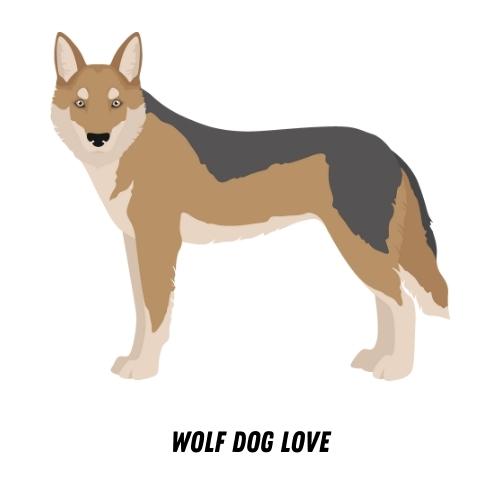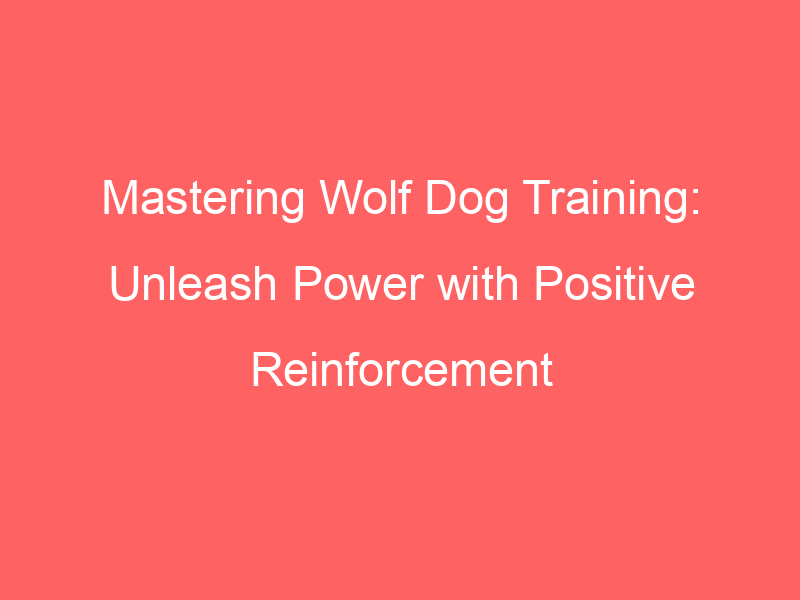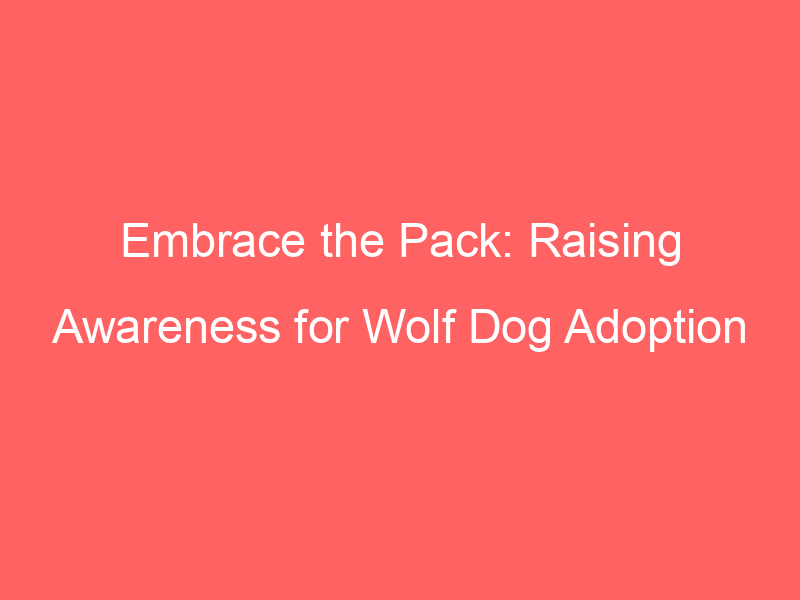Introduction to Wolf Dog Training
Wolf dogs are unique creatures, a blend of the wild and the domesticated. Training them requires a special understanding of their nature and needs. This article will guide you through the process of training your wolf dog, highlighting the importance of proper training, and discussing the challenges you might face.
- Understanding the unique nature of wolf dogs
- Importance of proper training
- Challenges in training wolf dogs
Wolf dogs are not your typical domesticated dogs. They are a mix of wild wolves and domesticated dogs, which gives them a unique set of behaviors and needs. They are intelligent, independent, and have a strong instinctual drive. This means they need a different approach to training than other dogs. Understanding their nature is the first step in successful wolf dog training.
Proper training is crucial for any dog, but it’s especially important for wolf dogs. Without proper training, wolf dogs can become unmanageable and even dangerous. Training helps to establish boundaries, enhance communication, and build a strong bond between you and your wolf dog. It’s not just about obedience, it’s about creating a harmonious living environment.
Training a wolf dog can be a challenging task. Their independent nature and strong instincts can make them resistant to traditional training methods. They are also highly intelligent, which means they can quickly become bored with repetitive tasks. However, with patience, consistency, and the right approach, it is possible to train a wolf dog effectively.
In the following sections, we will delve deeper into understanding wolf dog behavior, discuss positive reinforcement techniques, and share some effective wolf dog training tips. We will also share some success stories to inspire and motivate you on your wolf dog training journey.
Understanding Wolf Dog Behavior
Wolf dogs are unique animals, a blend of domestic dog and wild wolf. Their behavior can be quite different from other dog breeds. It’s important to understand their traits, how they differ from other breeds, and their body language to build a strong, respectful relationship with your wolf dog.
- Wolf Dog Behavior Traits
- How Wolf Dog Behavior Differs from Other Breeds
- Understanding Wolf Dog Body Language
Wolf dogs are highly intelligent and curious animals. They have a strong pack mentality, which means they value their family and their territory. They are also known for their independence and can be quite stubborn at times. However, they are also very loyal and protective of their loved ones.
Unlike most domestic dogs, wolf dogs have a strong prey drive and can be more challenging to train. They are not naturally obedient and will often test boundaries. They also require more physical and mental stimulation than most dog breeds. However, with the right training and socialization, they can become wonderful companions.
Wolf dogs communicate a lot through their body language. For example, a wagging tail doesn’t always mean they’re happy. It can also indicate nervousness or excitement. Ears pinned back can mean they’re scared or anxious. It’s important to pay close attention to these signals to understand what your wolf dog is trying to tell you.
Understanding your wolf dog’s behavior is the first step towards building a strong bond with them. It’s not always easy, but with patience and consistency, you can learn to communicate effectively with your wolf dog and enjoy a rewarding relationship.
Remember, every wolf dog is unique. What works for one might not work for another. It’s important to take the time to understand your wolf dog’s individual personality and behavior traits. This will help you better meet their needs and ensure they live a happy, healthy life.
In the next section, we will discuss positive reinforcement techniques that can be used to train your wolf dog effectively.
Positive Reinforcement Techniques
Training a wolf dog can be a challenging task. However, with the right techniques, it can be a rewarding experience for both you and your pet. One of the most effective methods is positive reinforcement.
What is Positive Reinforcement?
Positive reinforcement is a training method that encourages desired behaviors by rewarding your pet when they perform them. It’s all about adding something positive to increase a behavior.
- Definition and examples of positive reinforcement: Positive reinforcement is a concept in psychology that suggests a behavior is likely to happen again if it is followed by something pleasant. For example, if your wolf dog sits on command and you give it a treat, the dog will associate sitting with receiving a treat and is likely to do it again.
- Benefits of positive reinforcement in dog training: Positive reinforcement has numerous benefits in dog training. It helps build a stronger bond between you and your pet, it’s easy to implement, and it makes training a fun and rewarding experience for your wolf dog. Moreover, it encourages good behavior without causing fear or distress.
Remember, the key to successful training is consistency and patience. Positive reinforcement is not a quick fix, but a long-term solution to help your wolf dog understand what behaviors are desired and which are not.
Applying Positive Reinforcement in Wolf Dog Training
Positive reinforcement is a powerful tool in wolf dog training. It involves rewarding your dog for displaying desired behaviors, which encourages them to repeat these behaviors in the future. Here are three crucial steps to apply positive reinforcement effectively:
- Identifying Positive Behaviors
- Choosing Appropriate Rewards
- Timing of Reinforcement
Recognizing and understanding your wolf dog’s positive behaviors is the first step in positive reinforcement training. These can include sitting on command, not barking at strangers, or staying within the yard boundaries. It’s essential to observe your dog closely and note these behaviors, as they form the basis for successful training.
Once you’ve identified the positive behaviors, the next step is to choose suitable rewards. These rewards should be something your wolf dog loves and motivates them to repeat the behavior. It could be a favorite treat, a toy, or even praise and petting. Remember, the reward should be given immediately after the positive behavior to create a strong association.
The timing of reinforcement is crucial in positive reinforcement training. The reward should be given immediately after your wolf dog displays the desired behavior. This immediate reinforcement helps your dog associate the behavior with the reward, encouraging them to repeat the behavior in the future.
In conclusion, positive reinforcement is a powerful and effective method for wolf dog training. By identifying positive behaviors, choosing appropriate rewards, and timing your reinforcement correctly, you can help your wolf dog learn and grow in a positive and loving environment.
Empowering Dog Training
Empowering dog training is all about giving your wolf dog the tools they need to be confident, independent, and mentally stimulated. This approach to training focuses on building a strong bond between you and your wolf dog, and teaching them to make good decisions on their own.
Empowering Training Techniques for Wolf Dogs
Wolf dogs are unique creatures that require specialized training techniques. Here are some empowering training techniques that can help your wolf dog become more confident and independent:
- Building trust and confidence: Trust is the foundation of any successful training program. To build trust with your wolf dog, you should always be consistent, patient, and positive. Reward your dog for good behavior and never punish them for mistakes. This will help them feel safe and confident around you.
- Encouraging independence: Wolf dogs are naturally independent creatures. You can encourage this trait by giving your dog opportunities to make decisions on their own. For example, you can let them choose which direction to go on walks, or let them figure out how to solve a puzzle toy. This will help them develop problem-solving skills and confidence.
- Promoting mental stimulation: Mental stimulation is just as important as physical exercise for wolf dogs. You can provide mental stimulation by teaching your dog new tricks, giving them puzzle toys, or setting up an obstacle course in your backyard. This will keep their mind sharp and help prevent boredom and destructive behavior.
Remember, every wolf dog is unique and what works for one might not work for another. It’s important to be patient and flexible in your training approach. With time and consistency, you can help your wolf dog become a confident, independent, and mentally stimulated companion.
Wolf Dog Obedience
Training a wolf dog requires patience, understanding, and a consistent approach. One of the most crucial aspects of wolf dog training is obedience. Let’s delve into the basics of obedience training for your wolf dog.
Basic Obedience Training
Basic obedience training is the foundation for a well-behaved wolf dog. It involves teaching your wolf dog simple commands, maintaining consistency in your training methods, and dealing with disobedience effectively.
- Teaching Basic Commands
- Importance of Consistency
- Dealing with Disobedience
Start with simple commands like ‘sit’, ‘stay’, and ‘come’. Use a clear and firm voice when giving these commands. Remember to reward your wolf dog with a treat or praise when it follows your command. This positive reinforcement encourages your wolf dog to repeat the behavior.
Consistency is key in obedience training. Use the same words and gestures for each command. This helps your wolf dog understand and remember what is expected. Also, ensure everyone in your household follows the same rules and commands. This prevents confusion and helps your wolf dog learn faster.
Disobedience can be a challenge in training. If your wolf dog disobeys a command, stay calm and patient. Do not punish your wolf dog as this can lead to fear and aggression. Instead, repeat the command and reward your wolf dog when it complies. Remember, patience and persistence are essential in obedience training.
In conclusion, basic obedience training is an essential first step in training your wolf dog. It sets the foundation for advanced training and helps build a strong bond between you and your wolf dog. Remember, patience, consistency, and positive reinforcement are key in successful obedience training.
Advanced Obedience Training
After mastering the basics, it’s time to move on to advanced obedience training. This stage is crucial for wolf dogs as it helps them adapt to various situations and overcome challenges that may arise. Let’s delve deeper into this.
- Teaching Advanced Commands
- Training for Specific Situations
- Overcoming Challenges in Advanced Training
Advanced commands go beyond the basic ‘sit’, ‘stay’, and ‘come’. They include commands like ‘heel’, which instructs your wolf dog to walk right beside you, and ‘leave it’, which tells them to ignore something. Teaching these commands requires patience and consistency. Remember, every wolf dog learns at their own pace.
Wolf dogs, being intelligent and adaptable, can be trained for specific situations. This could be anything from behaving well in a crowded place to responding to emergency situations. For instance, the ‘quiet’ command can be useful in situations where silence is necessary. Training for these situations involves simulating the scenario and guiding your wolf dog on how to react.
Advanced training is not without its challenges. You might encounter resistance or lack of interest from your wolf dog. In such cases, it’s important to remain patient and persistent. Try changing your training methods or incorporating more rewards. Remember, the goal is to make learning a positive experience for your wolf dog.
| Command | Use |
|---|---|
| ‘Heel’ | Guides the wolf dog to walk beside you |
| ‘Leave it’ | Tells the wolf dog to ignore something |
| ‘Quiet’ | Commands the wolf dog to be silent |
In conclusion, advanced obedience training is a step up from basic training. It involves teaching more complex commands and preparing your wolf dog for specific situations. While it can be challenging, the rewards are immense. With patience, consistency, and positive reinforcement, your wolf dog can master advanced obedience training.
Wolf Dog Training Tips
Training a wolf dog can be a rewarding experience, but it also requires a unique approach. Here are some essential tips to help you navigate this process:
- Patience is key
- Consistency in training
- Understanding and respecting the wolf dog’s nature
Wolf dogs are intelligent and independent creatures. They may not respond to commands as quickly as other breeds. It’s crucial to remain patient and give them the time they need to understand and respond to your instructions. Remember, training is a journey, not a destination. It’s about building a bond of trust and understanding with your wolf dog.
Consistency is the backbone of any successful training program. This is especially true for wolf dogs. Make sure to use the same commands, gestures, and rewards each time. This consistency helps your wolf dog understand what you expect from them. The more consistent you are, the quicker they’ll learn.
Wolf dogs have a unique blend of dog and wolf traits. They are pack animals by nature and have a strong instinct to roam and explore. Understanding this can help you tailor your training methods to suit their needs. For example, wolf dogs may respond better to training sessions that incorporate elements of play and exploration. Always remember to respect their nature and never try to force them into behaviors that go against their instincts.
In conclusion, training a wolf dog requires patience, consistency, and a deep understanding of their nature. By following these tips, you can create a positive and productive training environment for your wolf dog.
Case Studies: Success Stories in Wolf Dog Training
Let’s delve into some real-life examples of successful wolf dog training. These case studies highlight the power of positive reinforcement and trust-building in overcoming challenges such as aggression and stubbornness.
-
Case Study 1: Overcoming Aggression with Positive Reinforcement
Meet Max, a wolf dog who was known for his aggressive behavior. His owners were at their wits’ end until they discovered the power of positive reinforcement. Instead of punishing Max for his aggression, they began rewarding him for good behavior. They used treats, praise, and extra playtime as rewards. Over time, Max began to associate good behavior with positive outcomes. His aggression decreased significantly, and he became a much happier and more relaxed dog. This case study shows that even the most aggressive wolf dogs can change their behavior with the right training approach.
-
Case Study 2: Building Trust with an Abused Wolf Dog
Next, we have Bella, an abused wolf dog who was terrified of humans. Her new owners knew they had to build trust with Bella before they could start any training. They began by giving Bella her space, allowing her to come to them when she felt comfortable. They spoke in soft, soothing tones and made slow, deliberate movements. Over time, Bella began to trust her new owners and was able to start her training journey. This case study demonstrates the importance of patience and understanding in wolf dog training.
-
Case Study 3: Successful Obedience Training of a Stubborn Wolf Dog
Finally, let’s look at Rocky, a stubborn wolf dog who refused to follow commands. His owners decided to try obedience training. They started with simple commands like “sit” and “stay,” using treats as a reward. They also used a clicker to mark the exact moment Rocky followed a command. Over time, Rocky began to understand what was expected of him and started following commands more consistently. This case study proves that even stubborn wolf dogs can learn to obey with consistent, positive training methods.
These case studies show that with patience, understanding, and the right training methods, any wolf dog can become a well-behaved and happy pet. Remember, every wolf dog is unique and may require a different training approach. The key is to stay positive and never give up.
Conclusion: The Power of Positive Training Methods
As we conclude this comprehensive guide on wolf dog training, it’s crucial to revisit the key points and understand the power of positive training methods. Let’s dive in.
- Recap of the importance of positive reinforcement in wolf dog training
- Final thoughts on empowering dog training
- Encouragement for continued learning and training
Positive reinforcement is the cornerstone of effective wolf dog training. It’s a method that rewards good behavior, encouraging the dog to repeat it. Throughout this guide, we’ve seen how this approach not only fosters obedience but also builds a strong bond between the trainer and the wolf dog. It’s a method that respects the dog’s natural instincts and intelligence, leading to a happier, well-adjusted pet.
Empowering dog training goes beyond teaching commands. It’s about understanding your wolf dog’s unique needs and behaviors, and using that knowledge to guide your training approach. The goal is to empower your wolf dog to make the right choices, fostering a sense of independence and confidence. This approach, as we’ve seen, leads to more effective training and a stronger bond between you and your pet.
Wolf dog training is not a one-time event, but a continuous process. It’s important to keep learning, adapting, and improving your training methods. Remember, every wolf dog is unique, and what works for one may not work for another. Stay patient, stay positive, and keep exploring new ways to make training a rewarding experience for both you and your wolf dog.
In conclusion, the power of positive training methods lies in their respect for the wolf dog’s natural instincts and intelligence. They empower the dog, build a strong bond, and lead to effective training. So, embrace these methods, keep learning, and enjoy the journey of training your wolf dog.








